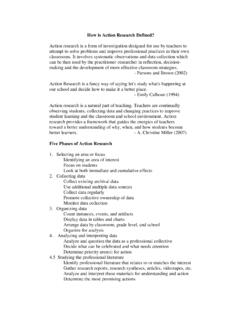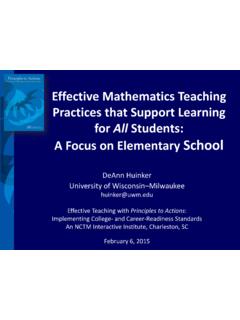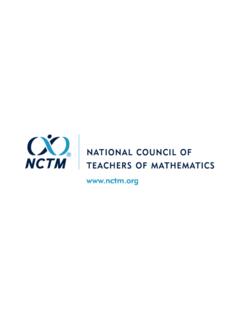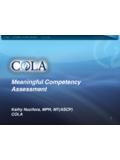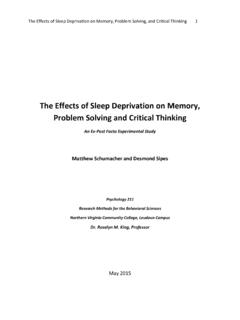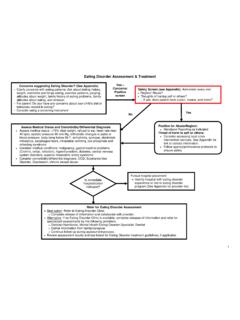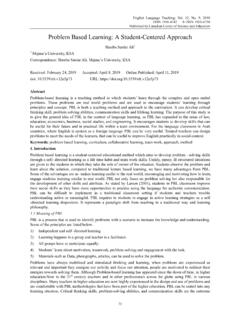Transcription of Some Formative Assessment Classroom Techniques
1 Some Formative Assessment Classroom Techniques 1. Clarifying, sharing and understanding learning intentions It is important that students know where they are going in their learning and what counts as quality work. WALT & WILF These are acronyms used by teachers to focus students attention on what they will learn and how they will recognise when they are making progress. WALT stands for We are learning and WILF for What I m looking Teachers use them in different ways to help them make sure that students know what they are going to learn (the learning intention) and how they will recognise progress (the success criteria). Choose-Swap-Choose Choose-Swap-Choose learners choose a good example of their own work from several they have made. They then submit these to a partner who then chooses the one he/she thinks is best.
2 The two students discuss their choices if there is disagreement. Design Test Items with Correct Answers Design their own test or test items for mid-term or end-of-term tests. This should be done while there is still time to make use of the feedback that emerges from this activity. In making test items, students clearly show what they think they have learned and what they think is important. 2. Eliciting Evidence of Learners Achievement It is important that teachers plan carefully and thoughtfully how to engage all students to ascertain what students know and understand. Popsicle Sticks The Popsicle stick approach to student engagement provide a random selection for answers, which means that the consistent hand-raiser isn t dominating Classroom discussion and evaluation.
3 Have each student write their name on a Popsicle stick and place all the sticks in a cup. Ask a question of the class, draw a stick from the cup and have the student whose name is on the stick respond to the question. All-student (random) response systems like this engage all students and sets an expectation that all students are worth hearing, dispel notions of favoritism, and perhaps more importantly identify gaps in student understanding. Formative Assessment Classroom Techniques 2 KWL Chart Know, Wonder, Learned The KWL chart is useful to complete Formative Assessment in the Classroom . It allows the teacher to find out the students prior knowledge on a particular topic. From this knowledge the teacher is then able to gear their lessons based upon this information.
4 The KWL chart can be completed when starting a new topic and be added to throughout the unit. Further, the teacher is able to find out what the students have learned by the end of their lessons. Topic: Things you already know Things you wonder Things you learned Think-Pair-Share Think-Pair-Share is a strategy in which the teacher poses a statement or asks a question of the class. Each student is given time to think and/or write down their answer. Once they have ample time to think and write, they pair-up with another student in the class, where they can discuss their answers. After they have had a chance to discuss their answers amongst themselves, they share their answers with a larger group or the rest of the class. Teachers can circulate through the class, as students are paired in discussion, to determine understanding.
5 All squares are rectangles ABCD Cards Each student receives one set of four cards individually marked A, B, C, and D. A, B, C, D cards can be used for questions having a single answer. However, they can also be used to respond to questions having more than one correct response and even questions that have no right or wrong answer. Formative Assessment Classroom Techniques 3 ABCD Corners or Four Corners Students are presented with a problem and four possible solutions to the problem . Each student thinks through the problem , writes his or her explanations, and selects the possible solution that best matches his or her explanation. Each corner of the room is labelled with one of the possible solutions. Students then go to the corner of the room that is labelled with their choice of possible solutions.
6 As small groups, students at each corner work through the problem and discuss. At any point, students may move to another corner. What is a good estimate for of A. I think the answer is close to 8. B. I think the answer is close to 20. C. I think the answer is close to 2. D. I think the answer is close to 80. Formative Assessment Classroom Techniques 4 Frayer s Model The Frayer Model is a vocabulary development tool. In contrast with a straight definition, the model helps to develop a better understanding of complex concepts by having students identify not just what something is, but what something is not. The center of the diagram shows the concept being defined, while the quadrants around the concept are used for providing the details. Definition A closed 2D figure made up of straight lines.
7 Characteristics Flat No gaps in the edges Examples Triangle Square Pentagon Non-Examples Point Line Circle Sticky-Note Collect and organize data quickly by giving each child a sticky-note and asking him or her to answer a question and post his or her response on a class graph, in a Venn Diagram, or similar to ABCD cards. Card Sorts Students work individually or in small groups to sort a set of cards according to a given characteristic or category. The cards can be numbers, shapes, symbols, words, or pictures. Variations: Have students sort the cards but do not give pre-defined categories have students sort and then explain and justify.) 7/10 3/4 5/12 1/8 6/8 Polygon Formative Assessment Classroom Techniques 5 Example/Non-Example Students provide examples and non-examples for a specific math definition or concept.
8 Shapes with four sides that are rectangles Shapes with four sides that are not rectangles What rule did you use to decide whether a four-sided shape is a rectangle or not Hot Seat and Waiting Time In the Hot Seat technique, one student is chosen to answer several teacher questions. Another student is then chosen to summarize or report on what the first student answered. The teacher then gives his or her evaluation. The reason for this is to give learners enough waiting time to process and evaluate in their own heads the answers of their peers before the teacher provides the correct answer. Without that waiting time, learners just listen and wait for the right answer from the teacher rather than develop the habit of evaluating ideas themselves.
9 Without using the square root button on your calculator, estimate as accurately as possible to two decimal places. Exit Passes/Exit Pass Place Mat The exit pass is simply a question that is posed to all students prior to class ending. Students write their answer on a card or piece of paper and hand it in as they exit (hence exit pass). This Formative Assessment technique engages all students and provides evidence of student learning for the teacher. Why can t you have a probability greater than 1? The exit pass is a great in class Assessment tool that can also help plan instruction. Teachers gain understanding of who knows what and if additional instruction is needed. Exit Pass place mat can be used if students place their names on the back of their exit card.
10 The teacher can use the exit pass as a place setting to create homogeneous to work with students who are having difficulty, or heterogeneous groups in which students can work through ideas. Why is a square a trapezoid? Formative Assessment Classroom Techniques 6 3. Providing Feedback that Moves Learning Forward Effective feedback should be focused and related to the learning goal causing students to think. The primary purpose of feedback should be to increase the extent to which students are owners of their own learning. Three Questions This is a technique teachers use to respond to students writing and problem solving . As a teacher reads student s work, when she see something on which she would like the student to reflect, she place a number circle at that point in the text.
